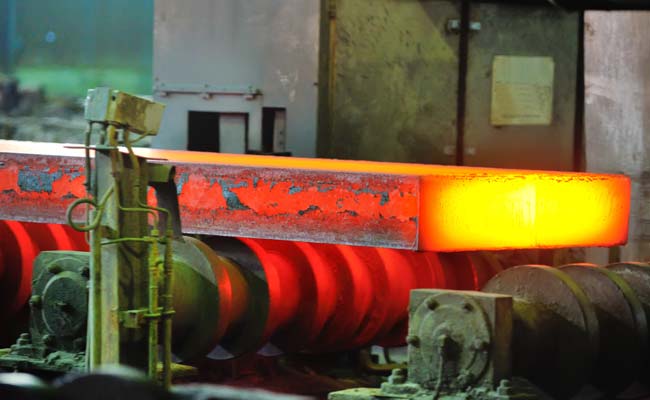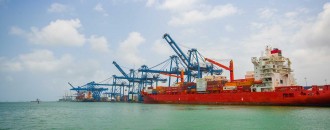
District Mineral Foundation to hit steel producers hard
The Dollar Business Bureau  The EBITDA/t (earnings before interest, tax, depreciation and amortization divided by total revenue) for the top six steel producers is expected to come under further stress in view of the stipulated additional contribution by iron ore miners towards District Mineral Foundation (DMF) under the new Mines and Minerals (Development and Regulation) (MMDR) Amendment Act 2015. Consequently, the gross leverage of top six steel producers in India could increase marginally, said a credit rating agency report. The possibility of debt levels moderating in FY16 remains low as most players have on-going expansion plans. The proposed contribution to DMF will be in addition to the royalty already being paid by miners. Though the contribution towards DMF could be as high as 100% of the royalty, the central government has the flexibility to fix the contribution percentage to the DMF based on the category of mining leases. The report says that it believes the finalisation of the contribution will be decided over the next quarter. The report estimates the additional payout could go up to Rs 71 bn, assuming a payout equivalent to 100% of the royalty to DMF. However, the additional burden on the existing iron ore miners could reduce to RS 23 bn, if the payout to DMF is limited to 33% of the royalty by the central government. It would entail an average product price increase of RS 153/t-RS 465/t to neutralise the impact of DMF, assuming 33%-100% contribution to DMF, respectively. In view of the escalation in cost incurred post-DMF introduction, the possibility of steelmakers passing on the additional burden to end-consumers remains constrained. This is because the sector continues to grapple with excess capacity as reflected through lower capacity utilisation and declining prices. Additionally, a capacity of 12-14 MT is likely to be added in FY16. Furthermore, pressure from imports (9MFY15: 7.2 MT, up 48% YoY) is also acting against the price increase. However, players could look at increasing the share of value-added products and focus on operational efficiencies. Additionally, a continued downward trend in hard coking coal prices to US$ 117/t in January 2015 from US$ 152/t in December 2013, and a possible imposition of anti-dumping duty on steel imports could help negate some of the impact unless supply pressures lead to a further reduction in steel product prices. The report expects primary steel producers having captive iron ore mines to see a higher payout in the immediate future as compared to those producers without captive iron ore linkages. The latter depend on either the purchase of domestic iron ore from players such as NMDC Limited or imports. Integrated primary steel producers are expected to commence payments towards DMF from the date the regulation would have been deemed to come into effect and hence could entail retrospective payments. Profitability for producers without captive iron ore linkages would depend on their ability to source imported iron ore at competitive rates, which have declined 57% YoY to US$ 50/t. For players dependent on domestic suppliers such as NMDC, the ability to negotiate prices would determine the impact on their cost structure. The report said that it sees a high possibility of iron ore imports into India, given the decline in iron ore prices. Also, captive iron ore miners could resort to imports if cost economics work out favourably. The Indian government charges one of the highest royalty rates in the world on iron-ore at 15%. Brazil and China, which produce around 40% of the world’s iron ore, have a royalty rate of 2%. Australia, the second-largest producer of iron ore, charges royalty between 2.7%-7.5%, depending on the type of ore. Historically, Indian iron ore miners were paying royalty on tonnage basis; however, in August 2009, the tonnage based payout system was replaced by ad-valorem based royalty. While initially the ad-valorem royalty rate was 10%, it was revised to 15% in 2014. Currently, the royalty amount equals Rs 555/t and Rs 405/t for lumps and fines, respectively. During FY11, post the replacement tonnage based system with ad-valorem duties, the royalty payout for three major steel producers increased 111%. The MMDR Act has extended the period of mining lease up to 2020 for non-captive users of iron ore and up to 2030 for captive users. It is likely to provide greater clarity to existing mine owners as contributions up to the period of lease are fixed, as against the e-auction route wherein aggressive bidding could have led to much higher payouts by iron ore miners. The report said that it additionally believes the contribution to DMF is akin to payments to state governments, if the mines were auctioned as was the case with coal blocks.
The EBITDA/t (earnings before interest, tax, depreciation and amortization divided by total revenue) for the top six steel producers is expected to come under further stress in view of the stipulated additional contribution by iron ore miners towards District Mineral Foundation (DMF) under the new Mines and Minerals (Development and Regulation) (MMDR) Amendment Act 2015. Consequently, the gross leverage of top six steel producers in India could increase marginally, said a credit rating agency report. The possibility of debt levels moderating in FY16 remains low as most players have on-going expansion plans. The proposed contribution to DMF will be in addition to the royalty already being paid by miners. Though the contribution towards DMF could be as high as 100% of the royalty, the central government has the flexibility to fix the contribution percentage to the DMF based on the category of mining leases. The report says that it believes the finalisation of the contribution will be decided over the next quarter. The report estimates the additional payout could go up to Rs 71 bn, assuming a payout equivalent to 100% of the royalty to DMF. However, the additional burden on the existing iron ore miners could reduce to RS 23 bn, if the payout to DMF is limited to 33% of the royalty by the central government. It would entail an average product price increase of RS 153/t-RS 465/t to neutralise the impact of DMF, assuming 33%-100% contribution to DMF, respectively. In view of the escalation in cost incurred post-DMF introduction, the possibility of steelmakers passing on the additional burden to end-consumers remains constrained. This is because the sector continues to grapple with excess capacity as reflected through lower capacity utilisation and declining prices. Additionally, a capacity of 12-14 MT is likely to be added in FY16. Furthermore, pressure from imports (9MFY15: 7.2 MT, up 48% YoY) is also acting against the price increase. However, players could look at increasing the share of value-added products and focus on operational efficiencies. Additionally, a continued downward trend in hard coking coal prices to US$ 117/t in January 2015 from US$ 152/t in December 2013, and a possible imposition of anti-dumping duty on steel imports could help negate some of the impact unless supply pressures lead to a further reduction in steel product prices. The report expects primary steel producers having captive iron ore mines to see a higher payout in the immediate future as compared to those producers without captive iron ore linkages. The latter depend on either the purchase of domestic iron ore from players such as NMDC Limited or imports. Integrated primary steel producers are expected to commence payments towards DMF from the date the regulation would have been deemed to come into effect and hence could entail retrospective payments. Profitability for producers without captive iron ore linkages would depend on their ability to source imported iron ore at competitive rates, which have declined 57% YoY to US$ 50/t. For players dependent on domestic suppliers such as NMDC, the ability to negotiate prices would determine the impact on their cost structure. The report said that it sees a high possibility of iron ore imports into India, given the decline in iron ore prices. Also, captive iron ore miners could resort to imports if cost economics work out favourably. The Indian government charges one of the highest royalty rates in the world on iron-ore at 15%. Brazil and China, which produce around 40% of the world’s iron ore, have a royalty rate of 2%. Australia, the second-largest producer of iron ore, charges royalty between 2.7%-7.5%, depending on the type of ore. Historically, Indian iron ore miners were paying royalty on tonnage basis; however, in August 2009, the tonnage based payout system was replaced by ad-valorem based royalty. While initially the ad-valorem royalty rate was 10%, it was revised to 15% in 2014. Currently, the royalty amount equals Rs 555/t and Rs 405/t for lumps and fines, respectively. During FY11, post the replacement tonnage based system with ad-valorem duties, the royalty payout for three major steel producers increased 111%. The MMDR Act has extended the period of mining lease up to 2020 for non-captive users of iron ore and up to 2030 for captive users. It is likely to provide greater clarity to existing mine owners as contributions up to the period of lease are fixed, as against the e-auction route wherein aggressive bidding could have led to much higher payouts by iron ore miners. The report said that it additionally believes the contribution to DMF is akin to payments to state governments, if the mines were auctioned as was the case with coal blocks.
This article was published on April 25, 2015 – 12:06 pm IST.






 to success.
to success.